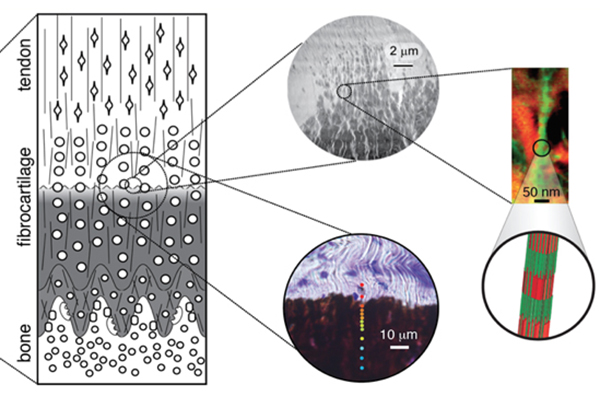Getting to the root of tough tissues through mechanobiology
Guy Genin and collaborators will use NIH funding to develop comprehensive models and conduct experiments to study the causes of the transition to a fibrous interface at the bone and tendon

Many adults in the U.S. have a tear in a rotator cuff, causing pain, activity limitations and often a difficult surgery with a high failure rate. To improve this outcome, researchers need to identify how healthy fibrous attachments at the intersection of the bone and tendon become tough.
Guy Genin, the Harold and Kathleen Faught Professor of Mechanical Engineering in the McKelvey School of Engineering at Washington University in St. Louis, and Stavros Thomopoulous, the Robert E. Carroll and Jane Chace Carroll Professor at Columbia University, have received a five-year, $2.44 million grant from the National Institutes of Health to develop comprehensive models and to conduct experiments to study the causes of the transition to a fibrous interface at the bone and tendon. They are building on previous work that showed that disorder is behind the toughening, while order provides the strength.
"We believe that these new models of fibrous attachment will allow us to understand how order and complexity define toughness and effective attachment of tissues," Genin said. "Order can relieve stresses that otherwise arise at the interface and strengthen it."
The interfaces between connective tissues in the body have to be tough enough to handle stress and strain, but also smooth enough to reduce friction. But following surgical repair to an injury, such as a rotator cuff tear, these smooth interfaces can become fibrous, and tough interfaces can become weak, although researchers do not know why. Genin, Thomopoulous and their collaborators plan to develop models to study what causes these interfaces to go from tough to weak. Included on the team are Ioannis Chasiotis, professor of aerospace engineering at the University of Illinois, an expert on testing of nanoscale fibers; Markus Buehler, the Jerry McAfee (1940) Professor in Engineering at Massachusetts Institute of Technology and an expert on first-principles modeling of fibers and their interactions; and Victor Birman, professor at Missouri S&T, an expert on functionally-graded materials.
Looking at tendon and bone in tissue samples and a mouse model of rotator cuff tendinopathy, they will study the stress concentrations that toughen the interface from the macroscale to nanoscale. They plan to use machine learning to validate their models in experiments through which they will determine whether energy absorption across hierarchies is a toughening mechanism by which these fibrous interfaces resist loads that lead to injury.
Ultimately, they expect the new models will allow researchers to understand how the order and complexity of fibrous attachments leads to the effective attachment of tissues.
Click on the topics below for more stories in those areas
- Research
- Mechanical Engineering & Materials Science
- The Institute of Materials Science & Engineering




